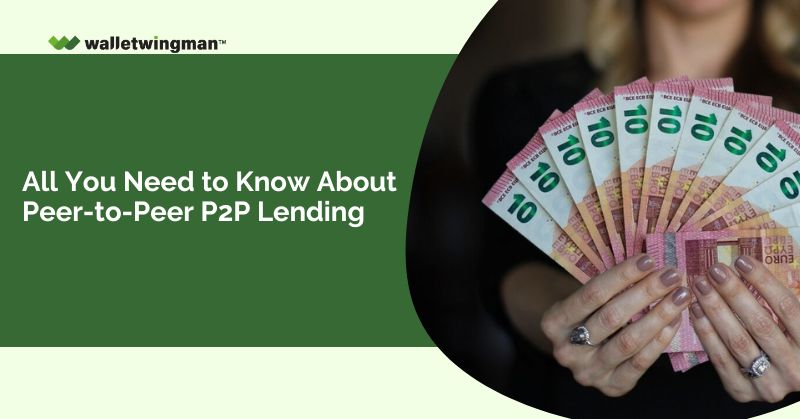For many people, if they want to get a loan, they go to a bank. This is traditional lending that a lot of people are familiar with.
This, however, has changed drastically, with many banks unwilling to give out loans. The outcome; many businesses have been left out in the sun.
The positive outcome, however, has been the growth of unconventional lending. One such method is Peer to Peer lending. A form of social lending that cuts out the middleman, i.e., the bank making it both an affordable option for borrowers and a lucrative business model for investors.

So, what is P2P lending?
As we’ve mentioned earlier, peer-to-peer lending is banking without the bank. You can think of it as a process where you borrow money from strangers. You, i.e., the borrower, go to a P2P website where individual investors are willing to give you a loan. The process, of course, is facilitated by a P2P company.
The outcome is that borrowers get lower interest rates than they would get at banks, and investors take on the risk of loan defaulters but a higher ROI.
How does Peer to Peer lending work?
The P2P process is pretty straightforward, with a few caveats/differences depending on whether you’re the investor or borrower.
From the borrower’s perspective
As a prospective borrower, the process is similar to what you’d expect at a bank, i.e., you are the loanee, and you’re looking to borrow money from a millionaire on the other side of the screen.
It’s not always a millionaire, most of the time. The process is as follows:
1. Registration
Depending on your chosen platform and its technology, you can expect a few base questions such as your address, Social Security number, name, and other personal information.
2. Risk Assessment
Once registered, the platform performs several analyses of your information to assess your risk as a borrower. This will determine whether to approve your request and what terms to set for the loan.
3. Funding
Once assessed and found eligible, you are presented with several options. You can browse the options, selecting the best fit for your situation.
From the investor’s perspective
If you want to lend the money, the process is as follows:
- Registering on the website -first, you open an account on the prospective website, after which you must deposit money. This, of course, is money you don’t have a set purpose for.
- The next step is to choose an investment and either fund the whole thing yourself or allocate your cash to smaller loans.
- The process is straightforward and takes a few minutes. After all, you must log onto the app to monitor your earnings and the progress of your various investments. You can reinvest the money or withdraw the cash from here.

Common Loan Types
One of the most significant advantages of using P2P lending is that you can get a loan to fund almost anything (it has to be legal).
Moreover, new sites have cropped up with the expansion of P2P lending, specializing in different types of loans. Some of the most common loans types include but are not limited to:
- Personal loans can include everything from paying for vacations to large purchases.
- Automobile
- Student loan
- Auto loans
- Personal loans
- Personal loans
- Mortgages
Advantages of Peer-to-Peer Lending
Using p2p lending has both its set of pros and cons for both parties,
For Borrowers
- Easy application process – as a borrower, the process between registering on a P2P platform and requesting a loan is pretty straightforward. Additionally, you get an answer within a few hours/ day.
- Lower interest rates: Compared to traditional banks, the interest rates from P2P platforms are set competitively and are great for borrowers with good credit scores.
- Flexible loan terms: when it comes to repayments, the terms are usually favorable, making it favorable for borrowers who want to customize the loan terms to their needs.
- Accessible source of funding: P2P lending has gained so much traction because of its accessibility to various people. In traditional lending institutions, borrowers with a low credit score are usually denied loan access.
- You can borrow money for quite several reasons. This makes it possible for virtually anyone to access funding for whatever purpose.
- For small businesses that have had a hard time accessing loans, P2P loans give them access to financing without jumping through hoops.
For Investors
- P2P lending makes it easy to diversify your funds: on P2P platforms, investors can see several borrowers. This allows several businesses to lend a specified amount of cash, thus diversifying their portfolio.
- Higher returns: Compared to other short-term instruments such as CDs, peer-to-peer lending has much higher returns on investment.
- Transparency over the investment: when a borrower registers on a P2P platform, they upload their personal information. Through this, investors can scrutinize where their money is going and assess how much risk they take while deciding how much to invest plus the interest rate.
Cons of Peer-to-Peer Lending
For Borrowers
- The interest rates can be pretty high for a borrower with a poor credit score or one who is considered a high risk. This can make it a less attractive option for such types of borrowers.
- The platform may charge you additional fees on top of the interest rates you will be paying.
- If, for some reason, you’re unable to repay your loan, you don’t have the same protections as what you’d receive from traditional lending. A P2P platform can transfer your details to a debt collection agency which could take you to court.
For Investors
- Investing in P2P lending carries a risk: similar to any investment. Despite all the credit checks the platform does, you may find that a borrower defaults on their payments. Moreover, if a borrower decides to default on payment, there isn’t much you can do about it.
- The ROI may be lower than expected if a borrower repays early. Some platforms may charge the borrower a prepayment fee. However, these fees may go toward the company and not the investor.
- There needs to be protection for your money. If a borrower defaults, the money is as good as gone.

How to choose a P2P lending platform?
- The type of loans: some platforms specialize in personal loans while others in business loans. Consider your reasons for applying.
- What are the charges/fees involved? – What charges will you incur? This goes for both investors and borrowers. Compare various platforms and choose the one that fits your needs.
- Look at the fees – some lenders may charge various fees, such as origination fees and other administrative costs, which may affect your loan amount.
- The prepayment fees – some companies charge a fee when you pay your loan sooner than what was stated. When looking at lenders, ensure they don’t have these costs.
- Secured vs. unsecured loans – some platforms may offer borrowers with bad credit history secured loans. The collateral can be anything from your house to your car. This may be a better fit if you have a bad credit history.
- Look at the platform’s security: You upload your personal information when registering. This could be lucrative to hackers. The platform you’re considering joining should have security measures to deter hackers and ensure everyone’s information is safe.
Is P2P lending safe?
Whether you’re a borrower or an investor, you may wonder if using a P2P platform is safe. For borrowers, it’s pretty secure. On the other hand, the answer could be clearer for investors.
Compared to other instruments, such as mutual funds and gold, which are influenced by the market, P2P is a much safer alternative.
The only ”major” risk associated with P2P is if the borrower defaults on a payment. The government doesn’t insure nor protect P2P loans. However, in most cases, the platform can assist with the recovery by filing a legal notice against the principal.
This can be easily mitigated by an investor diversifying their investment between different borrowers with high creditworthiness.

How much can you earn with P2P lending?
When talking about the potential ROI, this is influenced by several things.
- Your risk appetite. Like any other type of investment, the chances of scoring well are heightened if you’re willing to bat big. However, you shouldn’t invest money you can’t afford to lose.
- The creditworthiness of the borrower. When assessing who to give out loans to, P2P platforms check borrowers’ credit history. This is to analyze their repayment ability. Borrowers with a poor credit history are given a high interest. This, in turn, can mean a higher return for the investor.
- The platform fees – the website charges a certain amount to facilitate the process. These charges range across the board from platform to platform. However, you must factor in these charges.
The exact amount you can earn from investing in P2P lending isn’t confirmed, as everyone has a different story.
Summary
Peer-to-peer lending offers a lot of benefits for both lenders and borrowers. Although similar to traditional financial institutions, they differ in certain aspects.
If you want to get a loan from a P2P for whatever financial reason, you must research the various institutions well and pre-qualify. You can then stick to one and get things rolling.


